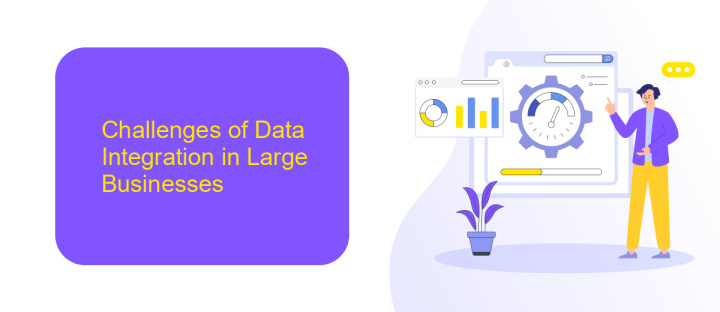Data Integration for Large Business
In today's fast-paced business environment, data integration has become a critical component for large enterprises aiming to maintain competitiveness. By seamlessly merging data from various sources, organizations can achieve a unified view of their operations, enabling more informed decision-making. This article explores the key strategies and technologies that facilitate effective data integration, ensuring businesses can harness the full potential of their data assets.
Introduction
In today's rapidly evolving digital landscape, data integration has become a critical component for large businesses aiming to leverage their vast amounts of data effectively. The need to consolidate disparate data sources into a cohesive system is more pressing than ever, as companies seek to gain actionable insights and maintain a competitive edge. This process involves combining data from various sources, ensuring its consistency, and making it accessible for analysis and decision-making.
- Enhancing data accuracy and consistency
- Streamlining business processes
- Facilitating real-time data access
- Supporting data-driven decision making
Effective data integration enables large enterprises to unlock the full potential of their data assets, leading to improved operational efficiency and better strategic outcomes. As businesses continue to grow and evolve, the importance of a robust data integration strategy cannot be overstated. By addressing challenges such as data silos and integration complexities, companies can ensure they remain agile and responsive in a dynamic market environment.
Challenges of Data Integration in Large Businesses

Data integration in large businesses presents several challenges due to the sheer volume and variety of data involved. One of the primary issues is ensuring data consistency across multiple sources. Large enterprises often rely on disparate systems and databases, making it difficult to maintain a single version of the truth. Additionally, data security and privacy concerns are paramount, as sensitive information must be protected against breaches and unauthorized access. The complexity of integrating legacy systems with modern applications further complicates the process, requiring significant time and resources to achieve seamless integration.
Another major challenge is the scalability of data integration solutions. As businesses grow, their data integration needs also expand, necessitating robust and flexible tools that can handle increasing data loads. Real-time data processing is essential for making timely business decisions, but achieving this can be technically demanding. Services like ApiX-Drive can simplify this process by offering automated data transfer and integration capabilities, reducing the burden on IT departments and enabling smoother operations. However, even with such tools, ongoing maintenance and monitoring are crucial to ensure the integration remains effective and efficient.
Benefits of Data Integration for Large Businesses

Data integration is a crucial aspect for large businesses aiming to streamline their operations and enhance decision-making processes. By combining data from various sources into a unified view, companies can achieve a higher level of efficiency and accuracy in their business activities.
- Improved Decision Making: Access to comprehensive and accurate data enables better strategic planning and informed decision-making.
- Increased Efficiency: Automated data integration processes reduce manual efforts and minimize errors, leading to more efficient operations.
- Enhanced Customer Experience: A unified view of customer data helps in providing personalized services and improving customer satisfaction.
- Cost Reduction: Streamlined data processes eliminate redundancies and reduce operational costs.
- Regulatory Compliance: Integrated data systems ensure that businesses meet regulatory requirements more effectively.
In conclusion, data integration offers significant benefits for large businesses, from improved decision-making to cost savings. By leveraging integrated data, companies can stay competitive and responsive in a rapidly changing market environment.
Data Integration Tools and Technologies

In the realm of large business operations, data integration is crucial for achieving seamless information flow across various departments and systems. Effective data integration tools and technologies help in consolidating data from disparate sources, ensuring consistency and accuracy. These tools are designed to handle large volumes of data, providing real-time processing and analytics capabilities.
Several data integration tools and technologies are available in the market, each offering unique features and capabilities. Choosing the right tool depends on the specific needs and infrastructure of the business. Below are some of the most popular data integration tools used by large enterprises:
- Informatica PowerCenter
- Microsoft SQL Server Integration Services (SSIS)
- Talend Open Studio
- IBM InfoSphere DataStage
- Oracle Data Integrator (ODI)
- Apache Nifi
These tools offer a range of functionalities, from ETL (Extract, Transform, Load) processes to real-time data integration and big data management. By leveraging these technologies, large businesses can ensure that their data is integrated efficiently and accurately, enabling better decision-making and operational efficiency.
- Automate the work of an online store or landing
- Empower through integration
- Don't spend money on programmers and integrators
- Save time by automating routine tasks
Best Practices for Data Integration in Large Businesses
For effective data integration in large businesses, it's crucial to establish a robust data governance framework. This involves setting clear data standards, ensuring data quality, and defining roles and responsibilities for data management. Regular audits and monitoring should be conducted to maintain data integrity and compliance with regulatory requirements. Additionally, leveraging scalable and flexible integration platforms can streamline the process and accommodate the growing volume of data.
Utilizing advanced integration tools like ApiX-Drive can significantly enhance the efficiency of data integration. ApiX-Drive offers seamless connectivity between various systems and applications, automating data transfer and reducing manual intervention. It supports a wide range of integrations, ensuring that data flows smoothly across different departments and systems. By implementing such tools, businesses can achieve real-time data synchronization, improve decision-making, and ultimately drive better business outcomes.
FAQ
What is data integration and why is it important for large businesses?
What challenges do large businesses face with data integration?
How can large businesses ensure data quality during integration?
What are some best practices for data integration in large businesses?
How can businesses automate and streamline their data integration processes?
Do you want to achieve your goals in business, career and life faster and better? Do it with ApiX-Drive – a tool that will remove a significant part of the routine from workflows and free up additional time to achieve your goals. Test the capabilities of Apix-Drive for free – see for yourself the effectiveness of the tool.


